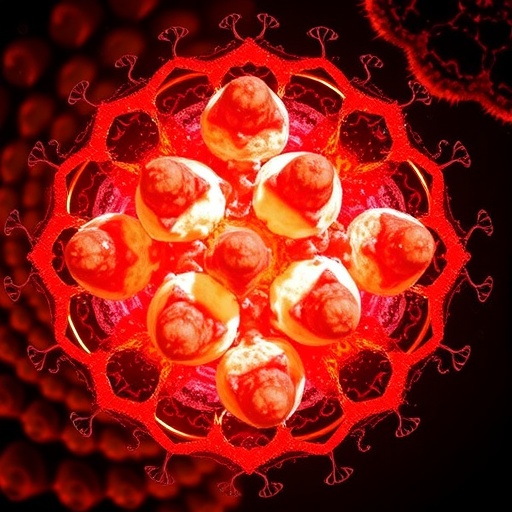In a groundbreaking study recently published in the prestigious journal Science, Chinese researchers have unveiled the astonishing complexity and efficiency of a mega photosynthetic assembly in coccolithophores, single-celled marine algae that play critical roles in oceanic carbon cycling and photosynthetic productivity. This pioneering work reveals the first ever three-dimensional structure of the photosystem I–fucoxanthin–chlorophyll a/c-binding protein supercomplex (PSI-FCPI) in Emiliania huxleyi, a dominant species of coccolithophore known for its distinctive calcium carbonate plates and its impact on global biogeochemical processes.
Coccolithophores represent a unique evolutionary lineage of phytoplankton that not only fix atmospheric carbon dioxide into organic compounds via photosynthesis but also precipitate calcium carbonate, thereby influencing the ocean’s optical properties and contributing significantly to carbon sequestration. Despite their ecological importance, the intricate structural mechanisms underlying their photosynthetic apparatus have remained elusive until now. This newly characterized PSI-FCPI supercomplex provides unprecedented insights into how these microscopic organisms optimize energy capture and conversion in vastly varying light environments of the open ocean.
The colossal photosystem complex discovered in E. huxleyi is the largest eukaryotic photosystem I assembly reported to date, with a molecular mass reaching approximately 1.66 megadaltons. It comprises an elaborate arrangement of 51 distinct protein subunits tightly integrated with 819 pigment molecules. This formidable architecture is a testament to evolutionary innovation, combining an expansive light-harvesting capability with ultrafast energy transfer dynamics that underpin photosynthetic efficiency exceeding 95%. Such exceptional quantum efficiency is critical for survival in the often light-limited and spectrally complex marine environments in which coccolithophores thrive.
Structurally, the PSI-FCPI supercomplex expands the light-harvesting cross-section of E. huxleyi by three to four times compared to canonical photosystem I complexes in other species. Its sophisticated composition features thirty-eight fucoxanthin–chlorophyll a/c-binding protein (FCPI) antenna complexes arranged in eight concentric radial belts surrounding the PSI core. These antennas are constituted by a combination of classical Lhcq subunits and newly identified Lhcq-like proteins, collectively orchestrating a “giant light-harvesting antenna system.” This intricate organization allows the photosynthetic apparatus to absorb a wider spectrum of sunlight, harnessing even low-intensity blue-green and green wavelengths prevalent in oceanic waters.
At the pigment level, the PSI-FCPI is uniquely tuned for marine light environments by incorporating abundant chlorophyll c and fucoxanthin-type carotenoids. Fucoxanthin, in particular, enhances absorption in the blue-green spectral region (460–490 nm), which penetrates most effectively into seawater layers. Importantly, the pigments are arranged to facilitate strong excitonic coupling between chlorophyll c and chlorophyll a molecules. This coupling minimizes energy dissipation traps and facilitates efficient exciton migration through the supercomplex, culminating in rapid excitation energy delivery to the PSI reaction center within an extraordinary timescale of 96–120 picoseconds.
This ultrafast energy transfer is fundamental to sustaining near-unity quantum efficiency in electron transfer reactions. The PSI reaction center then drives charge separation processes that convert the harvested light energy into chemical energy, powering CO₂ fixation and subsequent biomass production. By marrying massive light-harvesting capacity with swift and efficient energy transduction, the PSI-FCPI complex exemplifies the evolutionary optimization required for algae to dominate photosynthesis in nutrient-variable marine ecosystems.
Beyond its structural and functional revelations, the study illuminates a key chapter in the evolutionary history of red-lineage secondary endosymbiosis, during which photosynthetic eukaryotes inherited plastid organelles from engulfed red algae. The monumental scale and specialized features of the E. huxleyi PSI-FCPI complex represent an advanced stage of adaptation, reflecting evolutionary pressures to maximize solar energy capture in pelagic oceanic niches. This adaptive innovation likely contributed to the ancient flourishing and ecological success of coccolithophores since the Cretaceous period, a time when vast chalk deposits containing coccolith fossils accumulated on the ocean floor.
The implications of this discovery extend far beyond marine biology. Understanding the design principles and pigment-protein arrangements that afford such high-efficiency light harvesting has profound potential for bioinspired solar technologies. The natural PSI-FCPI supercomplex exemplifies spectral engineering strategies and ultrafast photonic energy transfer, providing a blueprint for the development of artificial photosynthetic systems and renewable energy materials. Insights derived from this research could catalyze breakthroughs in sustainable energy capture and conversion technologies.
The research team, led by Professors WANG Wenda and TIAN Lijin at the Institute of Botany, Chinese Academy of Sciences, employed cutting-edge cryo-electron microscopy and spectroscopy methods to resolve the 3D structure and dynamics of the PSI-FCPI supercomplex. This holistic experimental approach allowed them to precisely map pigment binding sites, protein interfaces, and energy transfer pathways with high spatial and temporal resolution. Their interdisciplinary work underscores the power of combining structural biology with photophysics to unravel the complexities of natural photosynthesis.
In summary, the elucidation of the Emiliania huxleyi PSI-FCPI supercomplex marks a paradigm shift in our understanding of marine photosynthetic machinery. This massive, intricately arranged photosystem not only exemplifies nature’s capacity to engineer extremely efficient light-harvesting systems but also enhances our comprehension of marine carbon cycling and evolutionary biology. As climate change increasingly impacts ocean ecosystems, such foundational knowledge is pivotal for predicting phytoplankton responses and their feedbacks on global carbon fluxes.
Further exploration of the PSI-FCPI and related complexes across different marine algae species promises to uncover new adaptive strategies and mechanisms of photosynthetic optimization. Continued advancements in microscopy and spectroscopic techniques will doubtless shed more light on the dynamic interplay between protein architectures and pigment networks in the ocean’s primary producers. Ultimately, this research enriches the scientific community’s toolbox for harnessing the principles of natural photosynthesis toward innovative environmental and energy solutions.
Subject of Research: Photosystem I-fucoxanthin–chlorophyll supercomplex structure and function in coccolithophores
Article Title: Structure and function of a huge photosystem I-fucoxanthin chlorophyll supercomplex from a coccolithophore
News Publication Date: 11-Sep-2025
Web References: https://doi.org/10.1126/science.adv2132
Image Credits: IBCAS
Keywords: Photosystems, Microalgae, Energy transfer, Lineage tracing, Marine photosynthesis, Photosynthesis




